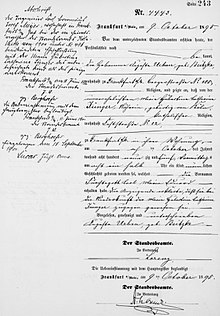Eduard Meyer (Lawyer)
Fürchtegott Carl Maria Eduard Meyer (born October 8, 1895 in Frankfurt am Main , † December 15, 1931 ) a German lawyer. He became known as the central figure in a scandal involving the National Socialist politician Ernst Röhm in 1931 and 1932.
Live and act
Meyer was born as the illegitimate son of Maria Hubertina Catharina Jünger. After his mother married the engineer Carl Boromäus Josef Meyer in 1900, he was recognized by him as a child and thus received the father's surname (Meyer).
Meyer took part in the First World War. Then studied law and then worked as a lawyer in Regensburg . At an unexplained point in time, he made friends with the National Socialist politician Ernst Röhm .
After Röhm was appointed Chief of Staff of the Sturmabteilung , the fighting organization of the NSDAP , at the beginning of 1931 , Meyer came to Berlin. In the weeks after the Stennes revolt in Berlin, on behalf of or at least with Röhm's consent, Meyer began researching some private letters that Röhm had written to the doctor Karl-Günther Heimsoth a few years earlier , in which Röhm came out as homosexual . Since Röhm had to regard his homosexuality becoming public as a danger to his political position in the NSDAP and to the popularity of his party among the voters - and homosexuality was also punishable by Section 175 of the Criminal Code - it was important to him to get these letters aside. According to Paul Schulz , Meyer demanded an excessively high sum from Röhm for his services, whereupon he tried to shake him off.
On June 22, 1931, the social democratic daily newspaper Münchener Post published under the title "Warm Brotherhood in the Brown House", in which it was reported about Ernst Röhm and the network of homosexuals surrounding him. The article essentially comprised an alleged report by Meyer to Röhm, dated May 22, 1931: In this report, in the form of a letter, Meyer, who posed as Röhm's news carrier, informed him of all sorts of alleged intrigues against him, Röhm, by other NSDAP members . The focus was on the claim that Röhm had given him, Meyer, the confidential order to steal the Heimsoth letters, the compromising content of which had been suggested, from the safe of Heimsoth's lawyer. Meyer finally explains that he had tried everything in vain to get at the letters - Röhm should therefore reimburse him for his expenses. When analyzing this incident, Susanne zur Nieden came to the conclusion that the motive of the extortionate sexual denunciation was clearly evident from the report.
A few days after the article was published, Röhm was questioned by the police on suspicion of violating Article 175 of the Criminal Code, whereupon he sued the Munich Post. The investigation quickly showed that Meyer's alleged report was not authentic. H. had ever been addressed to Röhm, but was specially made for publication in the Munich Post . Meyer and his girlfriend Elise Hergt, whom he had used as an intermediary, were charged with attempting fraud to the disadvantage of Röhm and for attempting fraud and forging documents in favor of the Munich Post . Meyer was also charged with perjury because he had denied under oath that he had contacted the post office on the matter. A few months later, Meyer was found hanged in his cell in the remand prison. Official cause of death: suicide.
The Meyer affair was of lasting political importance, as it made a significant contribution to publicizing the homosexuality of Röhm and some other SA leaders: As a result, the "Heimsoth letters" only mentioned in Meyer's report were used by the political opponents of the National Socialists actually found and published in 1932 in a widespread brochure by the social democrat Helmuth Klotz . A serious consequence of the publication of the Meyer Report and the subsequent trials was the beginning of the break between the SA leadership and the Political Organization (PO) of the NSDAP, which began in the events of the summer of 1931 and which, after being temporarily concealed, in June It culminated in the fall and murder of Röhm in 1934 and the political disempowerment of the SA in the course of the Röhm affair .
literature
- Scientific-Humanitarian Committee: Announcements of the Scientific-Humanitarian Committee eV , Issues 1–34 (1926–1933), DNB 01091241X .
- Susanne zur Nieden (Ed.): Homosexuality and reasons of state . Campus, Frankfurt am Main 2005, ISBN 3-593-37749-7 .
Individual evidence
- ^ Date of death after Lothar Machtan: Hitler's secret. The double life of a dictator , 2003, p. 214.
- ↑ Lothar Machtan: Hitler's Secret: The Double Life of a Dictator , 2003, p. 214.
| personal data | |
|---|---|
| SURNAME | Meyer, Eduard |
| ALTERNATIVE NAMES | Meyer, Fürchtegott Carl Maria Eduard (full name) |
| BRIEF DESCRIPTION | German lawyer |
| DATE OF BIRTH | October 8, 1895 |
| PLACE OF BIRTH | Frankfurt am Main |
| DATE OF DEATH | December 15, 1931 |
